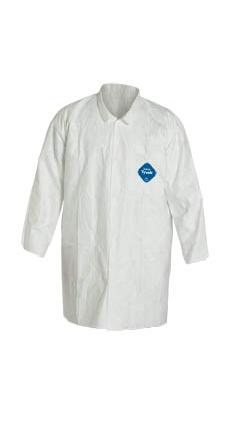Description
|
|||||||
|
Practically anywhere in industry, Tyvek® spunbonded olefin by DuPont™ has been hailed for years. It has served reliably as the unique material that imparts high strength, flexibility, durability, great barrier qualities and wearer comfort to protective clothing. Superior barrier, durability and breathability leave competitive materials far behind.
Superior barrier performance! Competitive materials possess poor levels of barrier durability or excessive porosity, so they offer much lower barrier protection. Tyvek® delivers the best possible balance of performance you can get. Superior durability! DuPont™ TYVEK® Nonwoven Fiber is built for the long run. Lakeland protective garments made with this enhanced material hang in with a durability superior to any other limited use material. Why? The tough barrier qualities of Tyvek® are found throughout the fabric. |
|||||||
| The DuPont® Tyvek™ lab coats are popular products. To make it easier to carry items around work, this style has two pockets. They're sold in packs of 30 and can be purchased in sizes ranging from small to 5X. The DuPont® Tyvek™ non-woven fiber material is used throughout the industry, and it has been a popular material for many years. It's a material that delivers exceptional durability, flexibility and strength. The DuPont® Tyvek™ lab coats have great barrier qualities, so they're able to protect workers against particulate and fluids. They offer superior breathability, durability and barrier strength. In fact, the Tyvek™ material outshines many competing products. A major problem with competing materials is low barrier durability. Some competing products also suffer from too much porosity. The DuPont® Tyvek™ material is hailed because it delivers an optimal balance of performance and comfort. The lab coats that are made from DuPont® Tyvek™ are designed to last, and they can withstand tough work conditions and keep workers safe from fluids. If you need some of the best lab coats that we have to offer, the DuPont® Tyvek™ lab coats should be considered. |
|||||||
|
|||||||
|
| Sizing Chart | ||
| Height | Weight(lbs) | Size |
| 6'8" | 240-300 | 4XL |
| 6'6" | 220-300 | 3XL/4XL |
| 6'4" | 180-280 | 2XL/3XL |
| 6'2" | 160-250 | XL/2XL |
| 6' | 160-250 | XL/2XL |
| 5'10" | 130-200 | L/XL |
| 5'8" | 130-220 | L/XL |
| 5'6" | 110-200 | M/L |
| 5'4" | 110-180 | S/M |
| 5'2" | 110-180 | S/M |
| 5' | 110-140 | S |
| This chart is a guide for garment selection, but proper fit varies with individual body shape and under-clothing. Test for proper garment fit before use. Garment performance depends on selecting appropriate size. |
||
OTHER DETAILS
Reviews (0)
Reviews (0) Hide Reviews Show Reviews
Write a ReviewWrite a Review
















